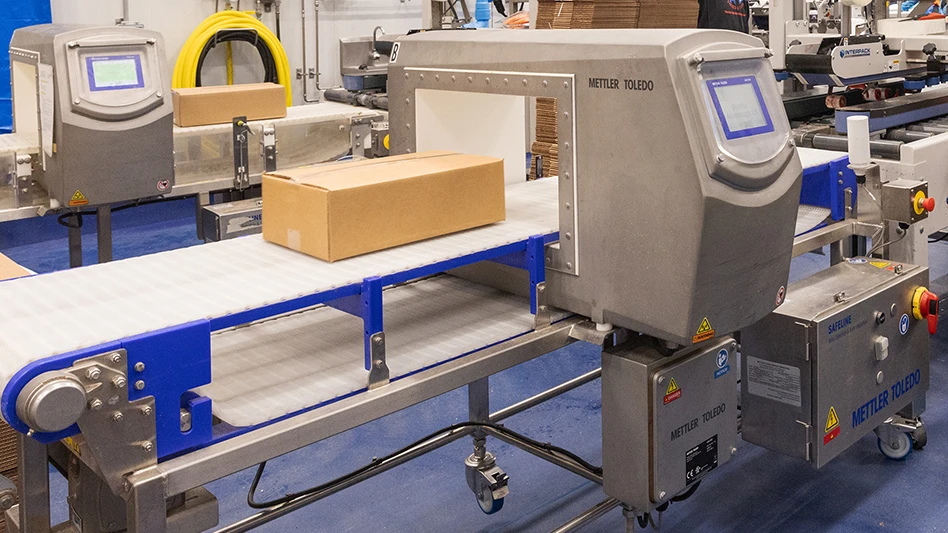
From mosquitoes and moths to ladybugs, wasps, beetles, and multiple types of flies, there are more than 300 flying insects that threaten food facilities which rely on highly consistent sanitation for compliance with regulatory standards, said Mars Air Systems Vice President of Foodservice Sales & Corporate Marketing Julie Konowitz.
Although the emphasis is often placed on flies, “mosquitoes and night-flying moths are more common intruders than common house flies,” said Gardner Manufacturing General Manager Bruce Studer. “Exterior lighting is the primary attractant to the facility.”
Brandenburg Technical Manager Arthur Dales agreed, citing the example of a food production facility that runs 24 hours a day and has an employee entrance with a few concrete steps and an exterior light next to the door for safety. “Night-flying insects will be attracted to the doorway after dark and easily enter the structure with employees,” he said.
Additionally, decaying debris in trash cans, drains and cracks and crevices can attract fruit flies, phorid flies, common house flies and bottle flies; standing water can bring mosquito infestations; and fall invaders, such as stinkbugs or Asian ladybeetles, may enter a facility in large numbers. Although these seasonal pests are seeking a place to overwinter and are not attracted to food or breeding sites, they can cause problems if they get into food production areas.
FLYING INSECT ATTRACTANTS. Odors and heat, along with trash, decaying food, scum, and debris will attract flying insects to food-processing facilities. In addition, said VM Products Representative John Brownlee, many facilities have aging infrastructures, such as old sewer lines in need of repair, that create breeding sites for flying insects.
“Insects, like all lower-order creatures, are driven by three things: food, shelter and procreation,” said Paraclipse President and CEO R. Brad Harse. “They are not flying around actively thinking about how to get into this or that facility.”
Thus, in addition to food odors and trash, the flying insects are drawn to light, both for heat and warmth (i.e., shelter), and the natural instinct to procreate. So, the presence of pheromones, from others of their species or an artificially placed attractant, also will draw them.
Areas with food waste or other organic material can be very attractive to filth flies, said Syngenta PPM Technical Services Manager Nicky Gallagher. Blow flies, in particular, are strongly attracted to odors of raw or cooked meat, poultry, or fish. Dumpsters typically provide an ideal food source and breeding site for filth flies.
In fact, filth flies will seek out wet decaying organic material for breeding and will follow both odor and moisture trails. Because all food processing creates some waste, it is almost always this that attracts filth flies, Dales said. “However, there are food production processes that rely on controlled decomposition of food — cheese making, baking, and brewing are obvious examples — where the filth flies have no way to distinguish between what we consider food and they consider a potential breeding site.”

FLYING INSECT ENTRY POINTS. Once attracted to a facility, flying insects will enter through open doors, unscreened vents, and other gaps through which attractants are emitted. “Openings in general — to include doors and windows without any type of a barrier to protect the opening — allow for free entry of flying insects,” Konowitz said.
“Besides open dock doors, the most common entry points in food-processing facilities are the roof vents that emit odors,” Studer added.
Brownlee has seen several facilities with issues such as missing or damaged door sweeps, lack of air curtains and gaps around bay doors that allow flying insects to enter, he said. “However, one of the biggest culprits I have noticed is doors being left open while bringing in stock, taking out garbage, and employees simply entering and exiting a facility.” And dumpsters and trash cans often are so close to the facility that simply leaving a door open for a few seconds allows flying insects to enter.
Although the point of entry for flying insects is usually the same as that used for personnel and materials, Dales said, “Floor channels for wastewater will often lead out of structures via less obvious means, and may provide a ‘hidden’ pathway for filth fly entry.”
Other areas that may allow flies to enter are dumpster chutes with poor sealants, weep holes, and wall voids. And small flies, such as fruit flies, could be breeding in ripe and fermenting fruits and vegetables, Gallagher added.
“Insects can enter when carried on or in deliveries of supplies and in pre-adult forms that can then hatch and develop in the ‘safer’ interior confines of a facility,” Harse said. “They also enter facilities when present in bulk materials that are brought into a facility for processing, as eggs, larvae, or adults.”
Then, once inside, flying insects can get into the food production area in search of food or simply a place to rest. “Many food-processing facilities operate continuously and do not allow for proper sanitation and cleaning. Deep cleaning is difficult or impossible due to the operational hours of many food-processing facilities,” Brownlee said. This not only attracts flying insects but can provide food, harborage, and breeding areas.
“The ingredients and materials used in the process are natural attractants,” Konowitz said. “Sugar, oils, and any number of other attractants can harbor the insect as well as the reproduction of its offspring, thus causing a serious food safety concern.”
EXCLUDING FLYING INSECTS. Given the various flying insects that are attracted to food-processing facilities, the many attractants that bring them to entry points, the array of entry points through which they can get in, and the problems they cause once inside, what can be done for prevention?
Following are 24 recommendations on practical applications of integrated pest management principles from the previously cited experts:
- Install fast-open screening, and maintain a positive air pressure to deter flying insects from entering.
- Cover roof vents that emit odors with fine mesh.
- Screen windows and doors as applicable, opening doors only when necessary.
- Use air curtains to protect entry points that are used frequently. The curtain ejects a stream of air across an opening to inhibit entry of flying insects, dirt, dust and fumes, while allowing for easy entry and exit of people. Air curtains can be particularly helpful for facilities which have workflow requiring that main doors or larger roll-up and dock doors be opened repeatedly or remain open for a period of time to allow workers and people-transporting equipment to pass through safely.
- Power down lights when not needed.
- Eliminate excessive moisture and areas of standing water.
- Use fly bait inside a secured fly-bait station to kill flies outside before they have a chance to enter. These can be particularly effective around dumpsters and near doorways. Some baits can be used inside a facility if secured inside a fly-bait station.
- Replace door sweeps and seals around loading docks when worn, and manage the times when doors and entryways are open.
- Use sanitation products that eliminate breeding sites to keep flies from reproducing if they do get inside. Microbial products break down the fats, oils, and grease and eliminate odors that can attract flies and provide harborage for egg-laying.
- Use lures to monitor flying insect activity by placing them on sticky traps.
- Remove lights that are next to doors or other openings. Instead, add a spotlight on a lamp post some distance from the door but directed toward it. This will provide the illumination needed for the employees, but will draw night-flying insects away from the door, reducing their potential for entry.
- Separate wastes and their handling from high-traffic entrances and provide as much distance between sensitive (and fly-attracting) production areas and external entrances as possible and practical.
- Place bottle/bag traps outdoors. Containing a liquid attractant, this bottle or bag system physically traps flying insects to reduce populations. They can be used indoors and outdoors, and are particularly effective near waste storage areas and along fence lines.
- Install insect light traps (ILTs) between entry points and sensitive areas to intercept flying insects before they can proceed further. The light traps should be positioned away from direct sunlight and preferably in areas with a shadowed or darker background.
- Because the ILTs literally attract the flying insects, don’t place them close to the areas you are trying to protect. Position them in line-of-sight but some distance away to draw the flying insects away from the area.
- Add other forms of insect traps, such as sticky cards/ribbons and pheromone-laced lures, as applicable. When effectively placed (both indoors and outdoors) they can be useful for monitoring or reduction of adult insects.
- Similarly, because trash bins attract pests, store these away from the building and entry ways.
- Keep trash bins, trash areas, and trash chutes clean to reduce attraction and breeding.
- Regularly clean all critical areas, including recycling containers, floor drains, or any other area that can hold water and food waste for prolonged periods of time.
- Scatter granular fly baits around dumpsters or use in bait stations placed near entry points to intercept potential invaders.
- Inspect incoming shipments that could transport fly eggs and larvae prior to bringing them into the facility.
- Ensure your upstream supply chain has controls in place. Infestations can develop in your facility from the hatching of moth eggs which were present in purchased bulk materials.
- Educate employees on the importance of communicating any insect problem they see as soon as possible. Honest communication from facility personnel regarding new infestation sightings or re-infestations is imperative for swift resolution.
- Work with your pest control technician; control of flies requires cooperation and correction of any exclusion and sanitation problems.
THE LAST WORD. Although people often think that small flies, such as fruit flies, are simply nuisance pests, Brownlee said, “All flies can carry pathogens that can contaminate food.”
“One of the largest barriers to control of pest flies is human acceptance,” said Dales, who cited a survey asking respondents which pest, when sighted, would prevent them from finishing a meal: a cockroach, rat, or fly. “Not surprisingly, almost all responded the rat or cockroach,” he said. “We see a fly buzzing around our food and just shoo it away. Yet most respected health officials consider filth flies to be a significant health threat. If a rat is seen during a food production shift it will probably result in immediate attention; similarly, with cockroaches. A fly however, well — not so likely.”
The author is Editor of QA magazine. She can be reached at llupo@gie.net.

Explore the April 2017 Issue
Check out more from this issue and find your next story to read.
Latest from Quality Assurance & Food Safety
- CSQ Invites Public Comments on Improved Cannabis Safety, Quality Standards
- Registration Open for IAFNS’ Fifth Annual Summer Science Symposium
- Leaked White House Budget Draft Proposes Shifting Inspection Responsibilities from FDA to States
- Chlorine Dioxide: Reset the Pathogenic Environment
- Ferrero Group Invests $445 Million in Ontario Production Facility
- Nelson-Jameson Announces Grand Opening for Pennsylvania Distribution Center
- Taylor Farms Linked to Romaine E. coli Outbreak as Marler Clark Files Multiple Lawsuits Against Supplier
- IAFNS Announces Winners of Emerging Leader Awards for Food Safety, Nutrition





